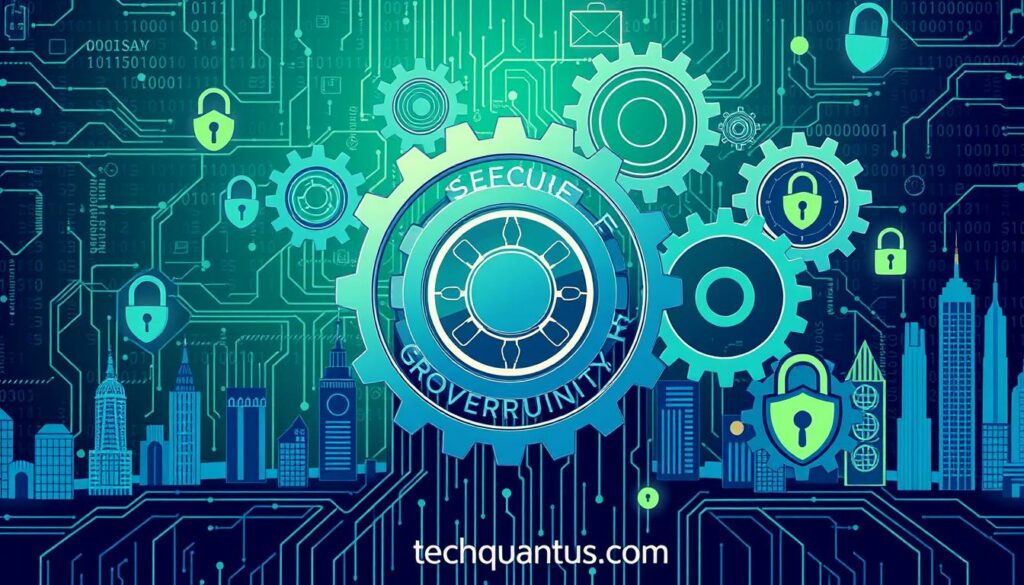In today’s digital world, knowing about security principles is key for anyone in cybersecurity. These principles are the core of good cybersecurity practices. They help protect important data and keep digital systems trustworthy. By understanding these basics, you can handle the challenges of threats and weaknesses that companies face.
With companies using AI and cloud tech to get better and grow, it’s more important than ever to know these principles. We’ll look at important ideas like confidentiality, integrity, and availability. You’ll see how these ideas lead to the best ways to keep systems safe and are a big part of strong cybersecurity plans.
Key Takeaways
- Security principles are fundamental to establishing a robust cybersecurity framework.
- Understanding these principles helps navigate the complexities of today’s digital threats.
- Modern organizations rely increasingly on AI and cloud strategies for cybersecurity.
- Proactive measures, such as risk management and governance, play a critical role in cybersecurity.
- Confidentiality, integrity, and availability are the cornerstones of effective security practices.
- Emphasizing these principles can lead to enhanced enterprise resilience and innovation.
Introduction to Cybersecurity Principles
In today’s digital world, knowing the introduction to cybersecurity principles is key for companies to protect their data. These principles act as a guide to build a strong cybersecurity framework. They help keep sensitive information safe, ensure data is accurate, and keep systems running smoothly.
Recent data shows why these principles are so important. A 2023 Salt Labs report found that 94% of companies faced API security problems last year. This shows how crucial strong security measures are to fight off threats. By 2025, nearly half of enterprise APIs might not be managed, making them more vulnerable to risks.
To tackle these risks, companies need to use strategies like least privilege access. This reduces the attack surface during security updates. Also, tightening access controls can lower both internal and external threats, improving security.
As companies use more complex systems, like microservices, broad API permissions can be a big risk. Chaos engineering helps test system architecture, finding and fixing weak spots before they’re exploited. Automation tools are also important, but they must not overlook major issues, especially with wide API settings.
Building a solid cybersecurity framework is crucial for your organization’s safety. Understanding basic cybersecurity principles is the first step to a safer digital space.
For more on how cybersecurity has changed, like the rise of ransomware, check out this resource.
What Are Security Principles?
Understanding security principles is key for those in cybersecurity. These principles protect information systems. The main ones are confidentiality, integrity, and availability, known as the CIA Triad.
Each part is crucial for keeping data safe and reliable. Confidentiality means only the right people can see sensitive info. Encryption and access controls help with this.
Data integrity means the information is trustworthy and correct. Hashing and checksums check if data stays the same during sharing or storage. Availability ensures users can get to the info they need, which is vital for work.
Security principles together create a strong defense against threats. Knowing them well is essential for any organization. With new cyber threats, understanding these principles is more crucial than ever to keep digital assets safe.
Importance of Cybersecurity Principles in Today’s Digital Environment
In today’s digital world, cybersecurity is more important than ever. As we use more technology, the chance of cyber threats increases. Knowing these principles helps protect your digital space. Following security frameworks can lower the risk of data breaches and cyberattacks.
Strong cybersecurity acts as a shield for your data. Companies that focus on these principles are better prepared for cyber threats. This not only keeps data safe but also protects the company’s reputation. When customers see you care about security, they trust you more.
Here are some reasons why cybersecurity principles are crucial:
- Adaptability: These principles help you stay ahead of new threats.
- Reputation Management: A solid security plan shows you care about customer data.
- Regulatory Compliance: Many rules require you to follow these principles.
- Cost Efficiency: It’s cheaper to prevent breaches than to fix them after they happen.
In short, focusing on cybersecurity makes your digital space safer. By sticking to these principles, you can fight off threats, gain customer trust, and keep your business running smoothly.
| Factor | Impact |
|---|---|
| Adaptability | Enhances response to evolving threats. |
| Reputation Management | Builds customer trust and loyalty. |
| Regulatory Compliance | Ensures compliance with laws and regulations. |
| Cost Efficiency | Reduces long-term costs associated with breaches. |
Key Security Fundamentals to Know
Knowing the basics of security is key for any company wanting to boost its cybersecurity. These basics help shape strong cybersecurity plans. They prepare you to tackle threats head-on.
Threat modeling is a must. It’s about spotting threats to your systems and data. Knowing your weak spots helps you focus on the most important security steps. It also means you can set up strong defenses before trouble hits.
Vulnerability management is another big deal. Scanning your systems for weaknesses regularly helps lower risks. Keeping your software and hardware up to date is a big step in stopping attacks. Being proactive in this area is key to keeping risks low.
Being ready for security breaches is crucial. Having a solid plan for how to handle breaches means you can act fast and well. Training your team and doing drills makes your team stronger against attacks.
Doing risk assessments is vital for spotting threats and protecting your assets. These assessments help you find weak spots, understand risks, and put in place the right controls. Regular checks keep your security strong against new threats.
Understanding these security basics is the first step to a strong cybersecurity plan. Adding these to your work makes your team more aware of security. Knowing security best practices helps protect your data and keeps your clients and partners trusting you.
| Key Security Fundamentals | Description |
|---|---|
| Threat Modeling | Identification of potential threats and weaknesses in your systems. |
| Vulnerability Management | Continuous assessment and mitigation of system vulnerabilities. |
| Incident Response | Preparation and action plan for responding to security breaches. |
| Risk Assessment | Evaluation of potential risks to organizational assets. |
Confidentiality: Protecting Sensitive Information
Keeping information safe is key in cybersecurity. Companies must use many ways to keep their data safe from those who shouldn’t see it. Here, you’ll learn how to keep information safe and see why it’s so important.
Methods to Ensure Confidentiality
To keep information safe, companies can use several methods:
- Encryption: This makes data unreadable without a special key. So, even if someone tries to get it, they won’t understand it.
- Access Controls: Setting up who can see or change data helps keep it safe. It makes sure only the right people can access it.
- Data Masking: This hides certain data in a database. It keeps information safe while still letting people work with it.
- Regular Audits: Checking data protection policies often helps find and fix problems. It makes sure everything is being done right.
Real-World Examples of Breaches in Confidentiality
Some big cases show what happens when information isn’t kept safe:
| Organization | Year | Type of Breach | Impact |
|---|---|---|---|
| Equifax | 2017 | Data Breach | Approximately 147 million records exposed, leading to identity theft and severe financial implications. |
| Yahoo | 2013-2014 | Data Theft | 3 billion accounts compromised, undermining user trust and affecting business valuations. |
| Target | 2013 | Credit Card Breach | 40 million credit card accounts compromised, resulting in significant financial losses and reputational damage. |
These examples show how important it is to protect information. They also show the big risks of not doing so.
Integrity: Ensuring Data Accuracy and Trustworthiness
In cybersecurity, integrity is key for keeping data accurate and trustworthy. It ensures the information you use is complete, reliable, and safe from tampering. For organizations that value ensuring data trustworthiness, maintaining data integrity is essential.
There are several ways to protect data integrity:
- Hashing: This method turns data into a fixed-size string of characters, like a hash value. Any change in the data makes the hash different, helping spot changes.
- Checksums: A checksum is a simple way to check data integrity. It’s a value based on the data’s contents. If the data changes, so does the checksum, showing possible corruption or alteration.
- Digital Signatures: Digital signatures use cryptography to verify the authenticity and integrity of digital messages or documents.
These methods are crucial for ensuring data trustworthiness, especially in critical sectors like finance, healthcare, and law. Here’s a table that summarizes these methods and their effectiveness in keeping data integrity:
| Method | Functionality | Effectiveness |
|---|---|---|
| Hashing | Transforms data into a fixed-size string for integrity verification | Highly Effective |
| Checksums | Generates a value from data for detecting changes | Moderately Effective |
| Digital Signatures | Authentiates and verifies the integrity of messages/documents | Highly Effective |
As your organization deals with the digital world’s complexities, focus on data integrity and ensuring data trustworthiness. With the right strategies, your data will stay accurate and secure.

Availability: Keeping Systems Operational
In today’s fast-paced digital world, keeping systems up and running is key for security. It lets your business operate smoothly. By using different strategies, you can make your systems more reliable and reduce downtime risks.
Strategies to Enhance Availability
Many strategies can help improve system availability. Here are some important ones:
- Redundancy: Having duplicate systems means if one fails, another can quickly take over.
- Load balancing: Spreading work across multiple servers helps prevent any server from getting too busy.
- Disaster recovery planning: Having detailed plans for when outages happen ensures quick recovery.
By using these strategies, you build a strong system. This system supports constant access to important data and apps. It greatly improves your operational security.
Impact of Downtime on Businesses
Downtime can severely hurt businesses. It can cause financial losses and damage a company’s reputation. Here are some examples:
| Incident | Downtime Duration | Estimated Financial Loss | Reputation Impact |
|---|---|---|---|
| Major Retailer Outage | 2 Days | $50 Million | Significant Media Coverage |
| Streaming Service Blackout | 6 Hours | $15 Million | User Backlash |
| Financial Institution Failure | 12 Hours | $30 Million | Loss of Customer Trust |
These examples show how important system availability is. They highlight the risks of downtime. To protect your business, focus on strategies that keep systems running smoothly.
Understanding Risk Management in Cybersecurity
In today’s fast-changing tech world, risk management is key to keeping cybersecurity strong. By using a clear cybersecurity risk assessment plan, companies can spot threats, understand their risks, and focus on what’s most important. This way, they protect their valuable stuff and reduce weak spots.
A good risk management plan has a few main parts:
- Risk Assessment: Finding and studying risks to guide company choices.
- Risk Mitigation Strategies: Putting in place steps to lessen threats’ chances and effects.
- Incident Management: Creating and using plans to quickly and well handle security problems.
For example, the crypto market in 2024 is very unstable, with prices changing fast. To deal with this, traders use smart risk management tools, like crypto trading bots. These tools, like stop-loss orders and spreading investments, help control losses and keep profits steady.
Companies can use advanced tools, like those from ValueZone AI, which use AI to keep up with market changes. These tools fit different risk levels, letting traders pick what suits them best. They also have easy-to-use interfaces and flexible plans.
According to Salt Labs in 2023, 94% of companies faced API security problems. This shows how important good risk management is. Gartner says by 2025, many enterprise APIs will still not be managed, which is a big security risk. So, using strong access controls and the least privilege principle can really help protect against threats.
Better risk management not only keeps tech safe but also helps companies succeed in uncertain times. By focusing on cybersecurity and always checking risks, businesses can build a strong security culture. This culture can stand up to new threats.
For leaders wanting to improve their tech strategies and risk management, look into custom solutions that modernize and boost abilities. Learn more about technology strategy and how it can help organizations thrive in the digital age.
Security Governance: Frameworks and Policies
Creating a strong security governance framework is key for protecting your data and reducing risks. A good framework helps enforce security policies and practices in your organization. It builds a culture of security awareness and responsibility.
Establishing a Security Governance Framework
To build an effective security governance framework, focus on these key areas:
- Define Security Policies: Make clear policies that match your organization’s goals and legal needs.
- Assign Roles and Responsibilities: Choose people or teams to manage the framework and keep everyone accountable.
- Conduct Risk Assessments: Check for risks often to find weak spots and fix them.
- Implement Training Programs: Keep training employees on security rules and best practices to boost their knowledge.
Monitoring and Compliance in Governance
It’s vital to have systems in place to check if your security policies are followed. Regular checks and reports can spot any issues and help fix them fast. Here are important points for monitoring:
- Establish Auditing Procedures: Set up a plan for regular checks to see if policies are being followed.
- Utilize Automated Tools: Use technology to make tracking and reporting easier.
- Engage in Continuous Improvement: Use audit results to improve and update policies, keeping them current and effective.

Cybersecurity Best Practices for Organizations
In today’s digital world, it’s key for companies to follow cybersecurity best practices. These steps help protect data and systems. They also make a safe work environment for employees. Knowing your part in security policies helps keep both you and your company safe.
Employee Training and Awareness
Teaching your team about cybersecurity is vital. Learning about threats like phishing and malware is crucial. It helps stop security breaches. Training should cover:
- Spotting phishing and social engineering attacks.
- Knowing your company’s security rules.
- Telling someone about odd activities.
- Seeing the importance of digital safety.
Regular training keeps your team alert and informed. Make sure to offer ongoing workshops. This keeps everyone updated on new threats.
Implementing Strong Password Policies
Good password policies are a key part of your cybersecurity. Users should make strong passwords. These should have letters, numbers, and symbols. This makes it harder for hackers to get into your systems.
- Make sure passwords are unique for each account.
- Use multi-factor authentication (MFA) for extra security.
- Change passwords often and don’t reuse them.
Following these steps boosts security and meets industry standards. It helps protect against cyber threats. By sticking to these policies, you can lower risks and keep your data safe.
Emerging Cybersecurity Concepts and Trends
The world of cybersecurity is changing fast. Companies face new threats every day. They need to keep up with the latest trends to protect their data.
One big trend is using AI for security. These systems learn from past attacks and get better at stopping them. This means better security for everyone.
Another key idea is zero-trust architecture. It means never trusting anyone or anything by default. Every request is checked, making it harder for hackers to get in.
Automated defenses are also important. With so much data, tools help sort through it all. They make it easier for security teams to keep up.
It’s crucial for companies to keep up with these trends. Using the latest tech helps prevent attacks, not just react to them. This makes a company’s security stronger.
| Trend | Description | Impact on Cybersecurity |
|---|---|---|
| AI-Driven Security | Uses machine learning to improve threat detection and response. | Makes security faster and more accurate. |
| Zero-Trust Architecture | Does not trust anyone or anything by default and checks every request. | Reduces attack surfaces. |
| Automated Defenses | Uses automation for finding threats and responding to incidents. | Makes things more efficient and lets teams focus on important tasks. |
Security Principles in Action: Case Studies
Looking at real-world cybersecurity incidents teaches us a lot. Each case study shows how sticking to security principles can help. They show what goes wrong and how to avoid it, keeping data safe.
Lessons Learned from Notable Cybersecurity Incidents
Google’s Gmail service, used by over 2.5 billion people, faced a big threat. AI hacking has become a big problem. A Microsoft expert, Mitrovic, outsmarted a Gmail AI scam, showing the need for strong security.
To fight scams worldwide, Google teamed up with the Global Anti-Scam Alliance and the DNS Research Federation. They created the Global Signal Exchange. It uses Google Cloud and AI to track and stop scams. Users should be careful and not give out personal info to unknown senders.
These lessons remind us to teach everyone about cybersecurity. Checking if messages are real through account logs helps a lot. Using these lessons can make companies stronger against cyber threats.
Conclusion
Understanding and using security principles is key to a strong cybersecurity framework. This overview shows how important confidentiality, integrity, and availability are. They help protect sensitive data and keep trust.
As we deal with digital challenges, knowing these principles is vital. It helps us fight off new threats.
The world of cybersecurity is always changing. We must keep checking and updating our security plans. Companies must follow rules like those from the Payment Card Industry Security Standards Council (PCI SSC).
Not following these rules can cause big problems. This includes huge fines and issues with transactions. It shows why good security management is so important.
Looking forward, we must stay ahead of security risks. This includes focusing on API security and cloud-native systems. By being proactive, like doing regular checks and using new methods, we can better protect ourselves.
This summary reminds us that investing in security basics is essential. It’s key for success in today’s digital world.
FAQ
What are the core principles of cybersecurity?
The core principles of cybersecurity are confidentiality, integrity, and availability. These principles help organizations protect their digital assets. They guide in implementing effective cybersecurity practices.
Why is it important to follow security principles?
Following security principles is key in today’s digital world. They help organizations protect data and maintain customer trust. These principles are crucial in fighting off new cybersecurity threats.
How does confidentiality play a role in cybersecurity?
Confidentiality protects sensitive information from unauthorized access. Techniques like encryption and access controls are vital. They help keep information safe within an organization.
What methods are used to ensure data integrity?
Data integrity is ensured through hashing and checksums. These methods verify data accuracy and completeness. They prevent data tampering.
What strategies can maintain system availability?
To maintain system availability, organizations use redundancy and load balancing. Disaster recovery planning is also key. These strategies ensure continuous access to systems and data.
How important is risk management in cybersecurity?
Risk management is crucial in cybersecurity. It involves assessing risks and finding ways to mitigate them. Understanding these processes helps protect assets effectively.
What is security governance, and why is it needed?
Security governance guides an organization’s cybersecurity practices. It enforces security measures and monitors compliance. It ensures all employees know their cybersecurity roles.
How can organizations train employees on cybersecurity?
Organizations can train employees through awareness programs. These programs teach about security threats and best practices. They help create a security-conscious culture.
What are some emerging trends in cybersecurity?
Emerging trends include AI-driven security solutions and zero-trust architecture. Automated defenses are also important. These trends help adapt to changing cybersecurity threats.
Can you provide examples of notable cybersecurity incidents?
Notable incidents show the importance of following security principles. Analyzing these cases teaches organizations how to strengthen their security. It helps protect their assets.
Source Links
- 1. Technology Strategy
- 2. The Rise of Chicago as a Major Tech Hub in the Midwest
- 3. How to Ensure Cloud Native Architectures Are Resilient and Secure
- My Guide to Understanding Data Centre Architecture: Core Components Every IT Pro Should Know
- Wazuh Home Network Setup: A Step-by-Step Guide
- Quantum Computers Decrypting Blockchain: The Risks and Implications
- Wazuh: Enterprise-Grade Security for Your Business
- Wazuh for Beginners: A Comprehensive Guide
Related posts:
 The Impact of Quantum Computing on Cybersecurity
The Impact of Quantum Computing on Cybersecurity
 How Blockchain is Shaping the Future of IT Security
How Blockchain is Shaping the Future of IT Security
 How to Automate Cybersecurity Threat Detection Using AI
How to Automate Cybersecurity Threat Detection Using AI
 The Revolution of Modern Payment Apps: Security and Ease to Use
The Revolution of Modern Payment Apps: Security and Ease to Use
 CISSP Domain 3: Security Architecture and Engineering
CISSP Domain 3: Security Architecture and Engineering
 CISSP Domain 4: Communication and Network Security
CISSP Domain 4: Communication and Network Security
